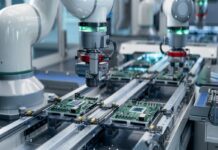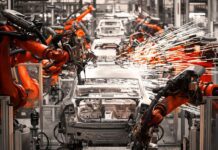
Article by Mark Fioretto, Area Vice President and Managing Director ANZ at UiPath
A new National Reconstruction Fund recently announced by the Federal Government aims to build a future made in Australia, with a specific focus on identifying and investing in manufacturing technologies that will help the nation transition to net zero emissions.
This will go a long way in supporting Australia’s manufacturing industry, which currently produces about two-thirds as much manufactured output as it consumes. The Australian Industrial Transformation Institute (AITI) characterises the country as having an industrial structure more akin to a developing country than that of a high-income advanced economy. This is due largely to a 30-year downward trend of Australian manufacturing output and employment that has been more pronounced since the Global Financial Crisis and recent resource booms.
The good news is that advanced manufacturing and the growth of smart factories have the potential to grow the domestic manufacturing sector by up to $30 billion over the next three years. However, this will take more than government funding to achieve. To grow and sustain a successful manufacturing industry in Australia over the longer term requires three fundamentals.
- Attracting skilled workers back to Australia’s manufacturing industry
- Ensuring manufacturers can achieve net zero emissions
- Scalable and agile manufacturing processes.
Attracting skilled workers back to the manufacturing industry
Like most industries, manufacturing is facing a shortage of skilled workers. Due to the nature of manufacturing that often requires manual, repetitive tasks, manufacturers may find it difficult to offer fully flexible work arrangements such as the “work from anywhere and anytime” environment that other industries can provide. While improving training opportunities and increasing wages is part of the solution, real value lies in ensuring employees are truly engaged in their work and motivated to do their jobs.
This is challenging, especially given a recent study showed that 22% of employees were considering leaving their current workplace, regardless of the salary offered. Therefore, manufacturers need to rethink the type of work they can offer and the flexibility they can provide if they want to attract skilled workers back to the industry and retain them.
It has become a top priority for manufacturers, with an IDC study showing that by the end of 2023, chronic worker shortages will prompt 60% of supply chain organisations to prioritise automation investments, resulting in productivity improvements of 20%. Over four in five manufacturers have already invested in automation to increase productivity, efficiency and collaboration in the workplace.
Ensuring manufacturers can achieve net zero emissions
Historically, manufacturing has been a major contributor to greenhouse gas emissions but the industry has taken significant steps to reduce carbon waste and achieved a 1.1% reduction in emissions intensity per year since 1990.
According to the IDC research, by 2024 around 40% of major manufacturing companies will have sustainability wholly embedded into their operations. Within the next two years the top areas of focus for sustainability in manufacturing will be optimising the energy efficiency of products and operations, reducing waste through methods such as the circular economy, driving cost efficiencies and incorporating responsible sourcing principles throughout the supply chain.
This demonstrates that the manufacturing industry is committed to playing a key role in helping Australia achieve its net zero goals, but to ensure deep and lasting emissions reductions, the industry must rapidly scale new technologies. The challenge is the heavy investment that organisations have already made in manufacturing infrastructure, which is quickly being outdated as technology continues to advance at breakneck speed.
Scalable and agile manufacturing processes
Smart factories, powered by end-to-end automation, are rapidly gaining momentum because they can deliver manufacturing processes at scale. They are also highly agile and can easily and cost-effectively pivot processes to keep pace with market changes.
In the digitally-led economy, it is crucial for any organisation to scale and shift to meet environmental needs. It’s even more important in manufacturing where a failed process or rapid customer shift can literally mean millions of lost production dollars per day. Agility in manufacturing involves having access to clean data and timely information insights to inform decision-making, and the automated ability to identify bottlenecks and trigger processes that can fix issues in real-time.
Current productivity, quality and compliance pressures mean that Australia manufacturers are racing to achieve the next stage of digital maturity that will give them the agility and scalability they need in the new economy. Achieving a high level of digital maturity puts manufacturers in a much stronger position to accommodate changing workplace needs and shifting regulatory requirements.
The common denominator that underpins all three fundamentals in manufacturing is end-to-end automation. In fact, manufacturers have already recognised this, with 14% of Asia Pacific manufacturers, and 30% of all Australian organisations moving to enterprise-wide robotic process automation deployment within the next three years. Through cost-effective, cloud-based technologies that can be integrated with legacy systems and processes, automation can improve the employee experience, help reduce carbon emissions by identifying more efficient workflows, and deliver scalable and agile processes.
Automation can also improve competitiveness and customer satisfaction by streamlining end-to-end order management throughout the supply chain and multi-channel engagements across areas such as marketing, sales and services. This provides more opportunities for employees to get off the production line and into more strategic roles that deliver a better workplace experience. As a result, it improves employee engagement, supports work/life balance, and ultimately achieves better staff retention and productivity.
For example, since deploying 25 software robots in 201 business processes in early 2022, multinational air conditioning manufacturer Daikin Industries has saved around 100,000 hours of productivity. This has empowered and encouraged employees to upskill their IT literacy for more strategic roles, and put the company in a position where it will be able to deliver on its FUSION-25 long-term growth strategy.
Australian manufacturers have already ushered in the fourth industrial revolution with the adoption of cloud computing, the Internet of Things (IoT) and artificially intelligent processes. End-to-end automation that improves efficiencies and scale across the supply chain is the next step in this journey and will prepare manufacturers for the fifth, sixth and seventh phases of the industrial revolution, which are already on the horizon.




















